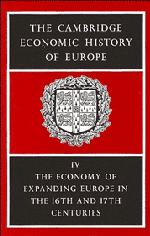Book contents
- Frontmatter
- Chapter I The Population of Europe from the Black Death to the Eve of the Vital Revolution
- Chapter II Scientific Method and the Progress of Techniques
- Chapter III Transport and Trade Routes
- Chapter IV European Economic Institutions and the New World; the Chartered Companies
- Chapter V Crops and Livestock
- Chapter VI Colonial Settlement and Its Labour Problems
- Chapter VII Prices in Europe from 1450 to 1750
- Chapter VIII Trade, Society and the State
- BIBLIOGRAPHIES
- References
Chapter I - The Population of Europe from the Black Death to the Eve of the Vital Revolution
Published online by Cambridge University Press: 28 March 2008
- Frontmatter
- Chapter I The Population of Europe from the Black Death to the Eve of the Vital Revolution
- Chapter II Scientific Method and the Progress of Techniques
- Chapter III Transport and Trade Routes
- Chapter IV European Economic Institutions and the New World; the Chartered Companies
- Chapter V Crops and Livestock
- Chapter VI Colonial Settlement and Its Labour Problems
- Chapter VII Prices in Europe from 1450 to 1750
- Chapter VIII Trade, Society and the State
- BIBLIOGRAPHIES
- References
Summary
Introduction
Among historians—as distinguished from administrators and writers on political arithmetic, both of whom were concerned with the present rather than the past—interest in demographic data was slow in arising. As late as 1764 Voltaire found it necessary to admonish his fellow-historians to pay more attention to questions of population. ‘On exige’, he wrote in his programmatic article ‘Histoire’ (Dictionnaire philosophique), ‘des historiens modernes plus de détails,…des dates précises,….plus d'attention à la population.’
Few modern historians, presumably, will demur at Voltaire's injunction; but most of us would protest that, in the field of population at least, his demand for ‘détails’ and ‘dates précises’ is difficult to meet. Indeed, the historian who undertakes to trace the demographic development of Europe in the early modern period has more than once occasion to recall Professor Sée's emphatic disclaimer, ‘Nous n'en savons rien et nous n'en pouvons rien savoir.’
Even if he does not fully subscribe to this declaration the historian of early modern population cannot fail to recognize that his task is formidable. Admittedly, the period to be covered is no longer innocent of statistical inquisitiveness. What seems to be the oldest reference to a count of ‘hearths’ (focaticum) dates from 1092; and Italian cities, no less precocious in this respect than in so many others, are known occasionally to have collected quasi-demographic intelligence as early as the twelfth and thirteenth centuries. On the eve of the modern era enumerations of one sort or another had long since ceased to be a novel feature of public administration, though it was only in sixteenth-century Italy (in Venice, on the island of Sicily, and a little later in Tuscany) that census-like data would be gathered as a matter of routine.
- Type
- Chapter
- Information
- Publisher: Cambridge University PressPrint publication year: 1967
References
- 18
- Cited by

